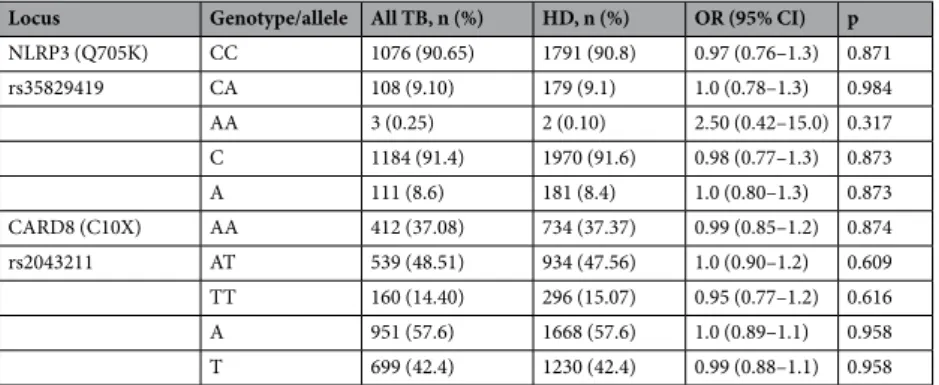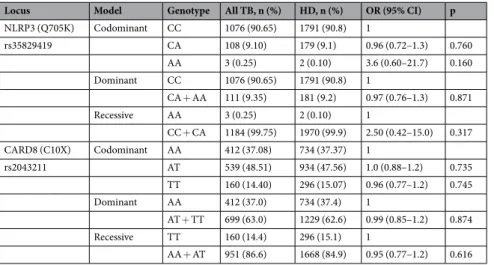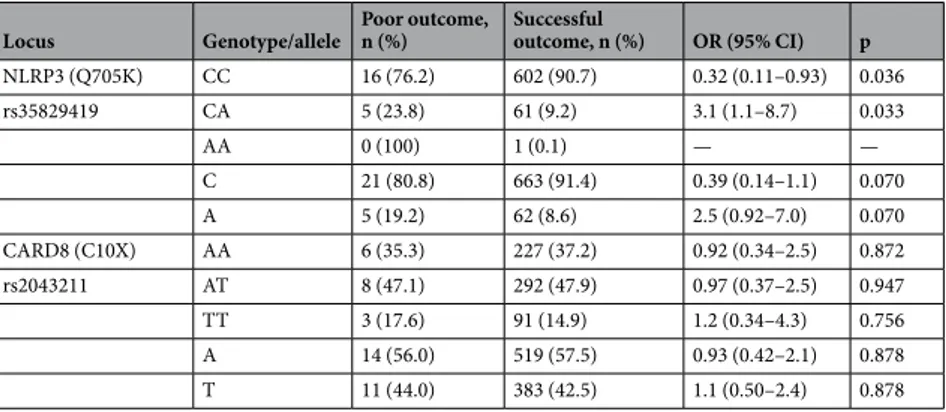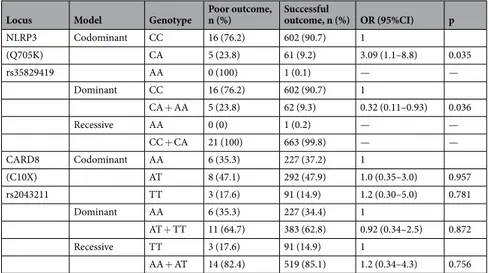Polymorphisms in CARD8 and
NLRP3 are associated with
extrapulmonary TB and poor
clinical outcome in active TB in
Ethiopia
Ebba Abate
1,2, Robert Blomgran
1, Deepti Verma
1,3, Maria Lerm
1, Mats Fredrikson
4,
Meseret Belayneh
5, Peter Söderkvist
6, Olle Stendahl
1& Thomas Schön
1,7Innate immunity is a first line defense against Mycobacterium tuberculosis infection where inflammasome activation and secretion of the pro-inflammatory cytokine IL-1beta, plays a major role. Thus, genetic polymorphisms in innate immunity-related genes such as CARD8 and NLRP3 may contribute to the understanding of why most exposed individuals do not develop infection. Our aim was to investigate the association between polymorphisms in CARD8 and NLRP3 and active tuberculosis (TB) as well as their relationship to treatment outcome in a high-endemic setting for TB. Polymorphisms in CARD8 (C10X) and NLRP3 (Q705K) were analysed in 1190 TB patients and 1990 healthy donors (HD). There was a significant association between homozygotes in the CARD8 polymorphism and extrapulmonary TB (EPTB), which was not the case for pulmonary TB or HDs. Among TB-patients, there was an association between poor treatment outcome and the NLRP3 (Q705K) polymorphism. Our study shows that inflammasome polymorphisms are associated with EPTB and poor clinical outcome in active TB in Ethiopia. The practical implications and determining causal relationships on a mechanistic level needs further study.
One peculiar feature of tuberculosis (TB) is that relatively few individuals become infected even after long-term household exposure1,2. It has been estimated that only 20–50% of exposed household contacts develop latent
TB within 2 years2. Thus, the remaining 50–80% mount an effective innate immune response which clears the
bacteria even before an adaptive cell-mediated immune response develops3. Innate immunity reactions include
mechanisms such as Toll-like receptor signaling and inflammasome activation leading to autophagy, release of pro-inflammatory cytokines, nitric oxide, and vitamin D-mediated antimicrobial peptide production3,4.
Inflammasome activation is critical for the clearance of bacterial pathogens and removal of damaged cells, but uncontrolled inflammasome activation can also enhance autoimmune disorders3–5. In Crohn’s disease and
rheumatoid arthritis (RA), a hyperactive inflammasome contributes to an excessive inflammatory response6,7.
In these cases, single nucleotide polymorphisms (SNPs) leading to a constitutively active NLRP3 inflammasome contribute to the disease manifestations. NLRP3 is a cytosolic pattern-recognition receptor that in response to pathogens and danger molecules mediates production of pro-inflammatory cytokines8. NLRP3 activation leads to
the recruitment of the adaptor ASC,which binds to NLRP3, and through its caspase recruitment domain (CARD)
1Division of Microbiology Infection and Inflammation, Department of Clinical and Experimental Medicine, Linköping University, Linköping, Sweden. 2Ethiopian Public Health Institute, EPHI, Addis Abeba, Ethiopia. 3Department of Clinical and Experimental Medicine, Division of Rheumatology, Linköping University, Linköping, Sweden. 4Department of Clinical and Experimental Medicine, Division of Environmental and Occupational Medicine, Faculty of Medicine Linköping University, Linköping, Sweden. 5Department of Medical Laboratory Sciences, University of Addis Abeba, Addis Abeba, Ethiopia. 6Division of Cell Biology, Department of Clinical and Experimental Medicine, Linköping University, Linköping, Sweden. 7Department of Infectious Diseases and Clinical Microbiology, Kalmar County Hospital, Linköping University, Linköping, Sweden. Correspondence and requests for materials should be addressed to T.S. (email: tschon@hotmail.com)
Received: 9 August 2018 Accepted: 7 February 2019 Published: xx xx xxxx
binds procaspase-1. Caspase-1 is subsequently activated to a catalytically active protease, which leads to the secretion of IL1-beta8. The Q705K polymorphism in NLRP3 has shown to be a gain-of-function SNP leading to
enhanced IL1-beta release5.
Caspase recruitment domain-containing protein 8 (CARD8), was recently shown to be a specific suppressor of NLRP3/ASC/procaspase −1 protein assembly, thereby inhibiting NLRP3-inflammasome activation9. The C10X
polymorphism in CARD8 leads to a truncated, non-functional protein with loss in CARD8-mediated inhibition of caspase-1.
Gain-of-function polymorphisms in the NLRP3 inflammasome resulting from gene polymorphisms such as NLRP3 (Q705K) and loss-of-function in relation to CARD8 (C10X) are associated to RA and Crohn’s disease, and some evidence for a combined effect of these polymorphisms have been described6,7.
M. tuberculosis, which replicates inside macrophages, uses its Esx-1 secretion machinery and the
membrane-damaging protein ESAT-6 to access the cytoplasmic compartment, thereby activating the NLRP3 inflammasome10. Furthermore, macrophages from individuals with combined CARD8 (C10X) and NLRP3
(Q705K) polymorphisms have been shown to limit intracellular growth of M. tuberculosis H37Rv more efficiently compared to wild-type cells11, suggesting a selective advantage for carriers of these polymorphisms in an TB
endemic setting.
With this background, the association between SNPs in the NLRP3 inflammasome (Q705K) or its regulatory protein CARD8 (C10X) and active TB including treatment response needs further investigation in large epide-miological studies in high-endemic areas. Our aim was therefore to explore the association between established polymorphisms (NLRP3 (Q705K) and CARD8 (C10X)) and pulmonary TB (PTB) as well as extrapulmonary TB (EPTB) including treatment outcome in Ethiopia, a high endemic setting for TB and in particular EPTB.
Results
Genotype distribution and allele frequencies in TB patients and healthy controls.
In total, 1190 HIV negative TB patients and 1990 controls (HDs) were included. SNPs were found to be in Hardy–Weinberg equilibrium (p = 0.79 and 0.99 for NLRP3 and CARD8 respectively). The median age in TB patients and HDs were 30 (IQR: 23–45) years and 25 (22–32) years, respectively. Female to male ratio in TB patients and HDs was 552/638 and 440/1546, respectively.The overall genotype and allele distribution of NLRP3 (Q705K) and CARD8 (C10X) is shown in Table 1. Association analyses for the co-dominant, dominant and recessive model are presented in Table 2. Overall, homozygotes in NLRP3 (Q705K) were very rare, and present in 0.1% and 0.25% of the HDs and TB patients, respectively. The recessive model showed a significantly higher presence of homozygotes in CARD8 (C10X) in EPTB (19.9% 69/347) compared to pulmonary TB (PTB) (odds ratio (OR): 1.8 (1.3–2.6); 12.0%; 91/759, p < 0.001) or HDs (OR: 1.4 (1.05–1.9); 15.1%; 296/1964, p = 0.024; Table 3). When adjusted for age and sex, the comparison between PTB and EPTB remained significant (adjusted odds ratio (aOR): 1.8 (1.3–2.5) p < 0.001). Females who were homozygotes in CARD8 (C10X) showed an inverse association to PTB (Table 4). An analysis of the combined effects of all genotype combinations of CARD8 (C10X) and NLRP3 (Q705K) adjusted for age and sex, showed no significant effect on the association to TB nor PTB or EPTB separately (p = 0.46, 0.39 and 0.83 respectively for homozygotes in CARD8 (TT) and heterozygotes in NLRP3 (CA)). No statistically significant associations between CARD8 (C10X) and active TB including PTB or EPTB were observed in the co-dominant or the dominant model (Tables 2 and 3).
Association between polymorphisms in CARD8 and NLRP3, and clinical outcome during
treat-ment of active tuberculosis.
Overall, males had an increased frequency of poor treatment outcome compared to females (6.8% (25/370) vs 1.6% (6/377), p < 0.001). The overall genotype and allele distribution of NLRP3 (Q705K) and CARD8 (C10X) in relation to treatment outcome is shown in Table 5 and the correspond-ing association analyses for the co-dominant, dominant and recessive model are presented in Table 6. Within the TB group, there was a strong association to poor treatment outcome in those heterozygous for Q705K of NLRP3 (aOR: 3.09 (1.09–8.80), p = 0.035, Table 7) in a co-dominant model adjusted for age and sex. This asso-ciation was particularly strong for females (aOR: 10.66 (2.06–55.26), p = 0.005). An analysis of the combined effects of all genotype combinations NLRP3 (Q705K) and CARD8 (C10X) adjusted for age and sex showed aLocus Genotype/allele All TB, n (%) HD, n (%) OR (95% CI) p
NLRP3 (Q705K) CC 1076 (90.65) 1791 (90.8) 0.97 (0.76–1.3) 0.871 rs35829419 CA 108 (9.10) 179 (9.1) 1.0 (0.78–1.3) 0.984 AA 3 (0.25) 2 (0.10) 2.50 (0.42–15.0) 0.317 C 1184 (91.4) 1970 (91.6) 0.98 (0.77–1.3) 0.873 A 111 (8.6) 181 (8.4) 1.0 (0.80–1.3) 0.873 CARD8 (C10X) AA 412 (37.08) 734 (37.37) 0.99 (0.85–1.2) 0.874 rs2043211 AT 539 (48.51) 934 (47.56) 1.0 (0.90–1.2) 0.609 TT 160 (14.40) 296 (15.07) 0.95 (0.77–1.2) 0.616 A 951 (57.6) 1668 (57.6) 1.0 (0.89–1.1) 0.958 T 699 (42.4) 1230 (42.4) 0.99 (0.88–1.1) 0.958
Table 1. Genotype and allele distribution of NLRP3 (Q705K) and CARD8 (C10X) in healthy donors (HD) and
possible association between heterozygotes in NLRP3 (Q705K) and homozygotes in CARD8 (C10X) (aOR 8.3 (0.76–90.3), p = 0.083) and risk for poor treatment outcome.
Discussion
The main result of this large-scale study on inflammasome polymorphisms in Ethiopia is an association between homozygotes in CARD8 (C10X) and EPTB as well as an association to an impaired TB treatment outcome in carriers of the NLRP3 (Q705K) polymorphism.
The distribution of homozygotes for the CARD8 (C10X) polymorphism is much less frequent in the European population (9.9%; 99/1003) compared to Ethiopian blood donors in the current study (15.1%, p < 0.001)12. The
rate of homozygotes (19.9%) in the CARD8 (C10X) polymorphism in EPTB patients is twice as high as in European blood donors (9.9%). We found a significantly higher frequency in CARD8 (C10X) homozygotes in EPTB patients from Gondar, Ethiopia in relation to healthy blood donors from the same area, which indicates that CARD8 (C10X) may be one contributing factor to the unexplained high rate of EPTB in this region13.
In a previous study, macrophages from heterozygotes in CARD8 (C10X) had a significantly impaired capacity to restrict M. tuberculosis growth. On the other hand, macrophages isolated from three combined heterozygote carriers of both polymorphisms (NLRP3 (Q705K)/CARD8 (C10X)) displayed enhanced anti-mycobacterial activity and increased IL1-beta production11. The interaction between the inflammasome and M.
tuberculo-sis should be further investigated as our current data combined with these pre-clinical observations indicate a
link between loss of control to restrict mycobacterial growth and association to EPTB in carriers of the CARD8 (C10X) polymorphism in the Ethiopian population.
EPTB is commonly manifested as generalized lymphadenopathy with higher rates of inflammation and a stronger pro-inflammatory reaction compared to other clinical forms of TB4. In patients with active TB, a hyper-reactive
Locus Model Genotype All TB, n (%) HD, n (%) OR (95% CI) p
NLRP3 (Q705K) Codominant CC 1076 (90.65) 1791 (90.8) 1 rs35829419 CA 108 (9.10) 179 (9.1) 0.96 (0.72–1.3) 0.760 AA 3 (0.25) 2 (0.10) 3.6 (0.60–21.7) 0.160 Dominant CC 1076 (90.65) 1791 (90.8) 1 CA + AA 111 (9.35) 181 (9.2) 0.97 (0.76–1.3) 0.871 Recessive AA 3 (0.25) 2 (0.10) 1 CC + CA 1184 (99.75) 1970 (99.9) 2.50 (0.42–15.0) 0.317 CARD8 (C10X) Codominant AA 412 (37.08) 734 (37.37) 1 rs2043211 AT 539 (48.51) 934 (47.56) 1.0 (0.88–1.2) 0.735 TT 160 (14.40) 296 (15.07) 0.96 (0.77–1.2) 0.745 Dominant AA 412 (37.0) 734 (37.4) 1 AT + TT 699 (63.0) 1229 (62.6) 0.99 (0.85–1.2) 0.874 Recessive TT 160 (14.4) 296 (15.1) 1 AA + AT 951 (86.6) 1668 (84.9) 0.95 (0.77–1.2) 0.616
Table 2. Association of NLRP3 (Q705K) and CARD8 (C10X) to all TB patients compared to healthy donors in
co-dominant, dominant and recessive models.
Locus Model Genotype EPTB, n (%) HD, n (%) OR (95% CI) p
NLRP3 (Q705K) Codominant CC 329 (89.9) 1791 (90.8) 1 rs35829419 CA 37 (10.1) 179 (9.1) 1.1 (0.77–1.6) 0.578 AA 0 (0) 2 (0.10) — — Dominant CC 329 (89.9) 1791 (90.8) 1 CA + AA 37 (10.1) 181 (9.2) 0.90 (0.62–1.3) 0.574 Recessive AA 0 (0) 2 (0.10) 1 CC + CA 366 (100) 1970 (99.9) 1.1 (0.052–22.4) 0.963 CARD8 (C10X) Codominant AA 123 (35.5) 734 (37.37) 1 rs2043211 AT 155 (44.7) 934 (47.56) 1.0 (0.78–1.3) 0.953 TT 69 (19.9) 296 (15.07) 1.4 (1.0–1.9) 0.051 Dominant AA 123 (35.5) 734 (37.4) 1 AT + TT 224 (64.5) 1229 (62.6) 0.92 (0.72–1.2) 0.489 Recessive TT 69 (19.9) 296 (15.1) 1 AA + AT 278 (81.1) 1668 (84.9) 1.4 (1.05–1.9) 0.024
Table 3. Association of NLRP3 (Q705K) and CARD8 (C10X) to EPTB patients compared to healthy donors in
inflammasome may drive the inflammatory state which could prolong the time to cure. Indeed, our data show a significant association between NLRP3 (Q705K) polymorphisms and poor clinical outcome. It is noteworthy that females show an even stronger association between poor clinical outcome and polymorphisms in NLRP3 (Q705K) despite better clinical outcomes in general than males. It has been shown that inflammasome activation may also cause inflammation and tissue damage in patients with TB-associated IRIS, who show early transcriptional responses14
including increased levels of IL1-beta and IL18 and enhanced upregulation of NLRP3 mRNA.
To our knowledge, this study is the largest so far to investigate the association between polymorphisms for CARD8 (C10X) and NLRP3 (Q705K) and active TB including treatment outcome. A small study of 288 patients with PTB and healthy controls in Brazil showed an increased risk of PTB in subjects with the rs10754558 polymorphism in NLRP3, but could not confirm an association to active TB in patients with either NLRP3 (Q705K) or CARD8 (C10X) nor in combination15. That study did not consider patients with EPTB and there was no report of treatment outcome. Our
results show that it is important to analyse different forms of TB separately as it has repeatedly been shown that EPTB is associated to a distinct host response compared to smear positive pulmonary or disseminated TB.
Our study has limitations. The major one is that latent TB screening was not done in blood donors. However, current methods as of tuberculin skin test and interferon-gamma release assays cannot adequately predict the true rate of LTBI, as a positive test is not necessarily associated with the presence of latent bacteria. Furthermore, the diagnosis of EPTB was mainly established clinically but according to WHO criteria and the majority of patients were cured after TB treatment. Although the data indicates an association between inflammasome pol-ymorphisms and EPTB as well as treatment outcome, causal relationships needs to be substantiated by further studies. Despite these limitations, our observations support the hypothesis that inflammasome-driven hyperin-flammation may affect the course of TB infection.
In conclusion, we found that polymorphisms in CARD8 (C10X) and NLRP3 (Q705K) leading to a more susceptible inflammasome were associated with EPTB and poor treatment outcome in patients with pulmonary TB, respectively. The results implicate a central role of the inflammasome in TB and may partly explain the high incidence of EPTB in the Ethiopian population.
Methods
Ethical considerations.
All patients and healthy individuals participated in the study after informed con-sent only. The study was conducted in accordance with the Declaration of Helsinki and was approved by the ethical review boards of Gondar University (RPO 05/489/2014) and Linköping University (2014/233-31).Patients and healthy individuals.
Newly diagnosed adult pulmonary TB patients at Gondar University Hospital, Gondar Health Centre and Debark Hospital, Ethiopia were consecutively recruited to the study. WHO-based criteria was used to define PTB and EPTB. HIV positive patients were excluded according to rou-tine investigations by using two different rapid testing kits with confirmation with a third one, if discrepanciesLocus Genotype All TB Cases p PTB p EPTB p
OR (95% CI) OR (95% CI) OR (95% CI)
NLRP3 (Q705K) CC 1 1 1 rs35829419 CA 1.13 (0.68–1.86) 0.645 1.30 (0.76–2.22) 0.332 0.66 (0.30–1.43) 0.295 AA 0.65 (0.032–12.7) 0.774 0.94 (0.05–18.69) 0.967 — — CARD8 (C10X) AA 1 1 1 rs2043211 AT 0.89 (0.66–1.22) 0.477 0.87 (0.62–1.22) 0.418 0.87 (0.56–1.37) 0.573 TT 0.91 (0.59–1.41) 0.683 0.57 (0.34–0.98) 0.040 1.66 (0.95–2.90) 0.073 Table 4. Association of NLRP3 (Q705K) and CARD8 (C10X) to all TB patients, EPTB and PTB patients
compared to healthy donors in a co-dominant model of females only, adjusted for age.
Locus Genotype/allele Poor outcome, n (%) Successful outcome, n (%) OR (95% CI) p
NLRP3 (Q705K) CC 16 (76.2) 602 (90.7) 0.32 (0.11–0.93) 0.036 rs35829419 CA 5 (23.8) 61 (9.2) 3.1 (1.1–8.7) 0.033 AA 0 (100) 1 (0.1) — — C 21 (80.8) 663 (91.4) 0.39 (0.14–1.1) 0.070 A 5 (19.2) 62 (8.6) 2.5 (0.92–7.0) 0.070 CARD8 (C10X) AA 6 (35.3) 227 (37.2) 0.92 (0.34–2.5) 0.872 rs2043211 AT 8 (47.1) 292 (47.9) 0.97 (0.37–2.5) 0.947 TT 3 (17.6) 91 (14.9) 1.2 (0.34–4.3) 0.756 A 14 (56.0) 519 (57.5) 0.93 (0.42–2.1) 0.878 T 11 (44.0) 383 (42.5) 1.1 (0.50–2.4) 0.878
Table 5. Genotype and allele distribution of NLRP3 (Q705K) and CARD8 (C10X) in relation to treatment
occurred. Treatment outcomes for TB patients were recorded according to the latest WHO guidelines. Treatment success included all patients whom were cured or completed treatment, whereas a poor treatment outcome was recorded for those with treatment failure, including death or default. Patients lost to follow up were recorded as uncertain outcome and were not included in the analysis. Apparently healthy blood donors (HDs) were recruited from the same community from the blood bank of the Gondar University Hospital. Active TB was excluded by the routine clinical screening at the blood bank.
Genotyping by real-time PCR.
Heparinized whole blood was collected and stored at −80 °C until DNA extraction in a MagnaPure96 instrument (Roche, USA). Genotyping was performed by a TaqMan®
SNP geno-typing assay with 7900HT Fast Real-Time PCR system (Applied Biosystems, Foster City, CA, USA) followed by allelic discrimination for the polymorphisms NLRP3 (Q705K, rs35829419) of and CARD8 (C10X, rs2043211). The final reaction contained 2 µL genomic DNA (20 ng), 10 µL 2x TaqMan®
Genotyping Master Mix (Applied Biosystems) and 0.5 µL of 20x TaqMan®
SNP Genotyping assays. Pre-designed primers and probes and a cut-off of <35 amplification cycles was used.Statistical analyses.
Descriptive data is presented as medians and interquartile ranges (IQR). Further, chi-square tests were performed to compare genotype including both a dominant (FF vs Ff + ff), codominant (FF vs Ff vs ff) and a recessive (ff vs FF + Ff) model. Binary logistic regression was used to calculate odds ratios (OR), adjusted odds ratios (aOR) and corresponding 95% confidence intervals (95% CI) in the co-dominant model. Interaction between genes in relation to age and sex were adjusted for using logistic regression analysis and p < 0.05 was considered as significant. Hardy–Weinberg equilibrium was calculated in accordance with standard procedures. The results were analysed by Statistica 12.0 software package (Dell Statistica software (version 13, Tulsa, USA)) and STATA 14.1 (StataCorp LLC, College Station, TX, USA).References
1. Morrison, J., Pai, M. & Hopewell, P. C. Tuberculosis and latent tuberculosis infection in close contacts of people with pulmonary tuberculosis in low-income and middle-income countries: a systematic review and meta-analysis. Lancet Infect Dis 8, 359–368,
https://doi.org/10.1016/S1473-3099(08)70071-9 (2008).
2. Verrall, A. J., Netea, M. G., Alisjahbana, B., Hill, P. C. & van Crevel, R. Early clearance of Mycobacterium tuberculosis: a new frontier in prevention. Immunology 141, 506–513, https://doi.org/10.1111/imm.12223 (2014).
Locus Model Genotype Poor outcome, n (%) Successful outcome, n (%) OR (95%CI) p
NLRP3 Codominant CC 16 (76.2) 602 (90.7) 1 (Q705K) CA 5 (23.8) 61 (9.2) 3.09 (1.1–8.8) 0.035 rs35829419 AA 0 (100) 1 (0.1) — — Dominant CC 16 (76.2) 602 (90.7) 1 CA + AA 5 (23.8) 62 (9.3) 0.32 (0.11–0.93) 0.036 Recessive AA 0 (0) 1 (0.2) — — CC + CA 21 (100) 663 (99.8) — — CARD8 Codominant AA 6 (35.3) 227 (37.2) 1 (C10X) AT 8 (47.1) 292 (47.9) 1.0 (0.35–3.0) 0.957 rs2043211 TT 3 (17.6) 91 (14.9) 1.2 (0.30–5.0) 0.781 Dominant AA 6 (35.3) 227 (34.4) 1 AT + TT 11 (64.7) 383 (62.8) 0.92 (0.34–2.5) 0.872 Recessive TT 3 (17.6) 91 (14.9) 1 AA + AT 14 (82.4) 519 (85.1) 1.2 (0.34–4.3) 0.756
Table 6. Association between NLRP3 (Q705K) and CARD8 (C10X) genotypes and poor treatment outcome in
all TB patients in co-dominant, dominant and recessive models.
Gene (Marker) Genotype All Cases p PTB p EPTB p
OR (95% CI) OR (95% CI) OR (95% CI) NLRP3 (Q705K) NLRP3 rs35829419 CA 3.09 (1.09–8.80) 0.035 3.92 (1.33–11.53) 0.013 — — AA — — — — — — CARD8 (C10X) CARD8 rs2043211 AT 1.03 (0.35–3.02) 0.957 1.10 (0.34–3.56) 0.867 0.62 (0.37–10.48) 0.195 TT 1.22 (0.30–5.03) 0.781 1.70 (0.39–7.40) 0.481 — —
Table 7. Association between NLRP3 (Q705K) and CARD8 (C10X) genotypes and poor treatment outcome in
3. Schon, T., Lerm, M. & Stendahl, O. Shortening the ‘short-course’ therapy- insights into host immunity may contribute to new treatment strategies for tuberculosis. J Intern Med 273, 368–382, https://doi.org/10.1111/joim.12031 (2013).
4. O’Garra, A. et al. The immune response in tuberculosis. Annu Rev Immunol 31, 475–527, https://doi.org/10.1146/annurev-immunol-032712-095939 (2013).
5. Verma, D. et al. The Q705K polymorphism in NLRP3 is a gain-of-function alteration leading to excessive interleukin-1beta and IL-18 production. PLoS One 7, e34977, https://doi.org/10.1371/journal.pone.0034977 (2012).
6. Kastbom, A., Johansson, M., Verma, D., Soderkvist, P. & Rantapaa-Dahlqvist, S. CARD8p.C10X polymorphism is associated with inflammatory activity in early rheumatoid arthritis. Ann Rheum Dis 69, 723–726, https://doi.org/10.1136/ard.2008.106989 (2010). 7. Schoultz, I. et al. Combined polymorphisms in genes encoding the inflammasome components NALP3 and CARD8 confer
susceptibility to Crohn’s disease in Swedish men. Am J Gastroenterol 104, 1180–1188, https://doi.org/10.1038/ajg.2009.29 (2009). 8. Man, S. M. & Kanneganti, T. D. Regulation of inflammasome activation. Immunol Rev 265, 6–21, https://doi.org/10.1111/imr.12296
(2015).
9. Ito, S., Hara, Y. & Kubota, T. CARD8 is a negative regulator for NLRP3 inflammasome, but mutant NLRP3 in cryopyrin-associated periodic syndromes escapes the restriction. Arthritis Res Ther 16, R52, https://doi.org/10.1186/ar4483 (2014).
10. Houben, D. et al. ESX-1-mediated translocation to the cytosol controls virulence of mycobacteria. Cell Microbiol 14, 1287–1298,
https://doi.org/10.1111/j.1462-5822.2012.01799.x (2012).
11. Eklund, D. et al. Human gene variants linked to enhanced NLRP3 activity limit intramacrophage growth of Mycobacterium tuberculosis. J Infect Dis 209, 749–753, https://doi.org/10.1093/infdis/jit572 (2014).
12. Sahdo, B. et al. Cytokine profile in a cohort of healthy blood donors carrying polymorphisms in genes encoding the NLRP3 inflammasome. PLoS One 8, e75457, https://doi.org/10.1371/journal.pone.0075457 (2013).
13. Berg, S. et al. Investigation of the high rates of extrapulmonary tuberculosis in Ethiopia reveals no single driving factor and minimal evidence for zoonotic transmission of Mycobacterium bovis infection. BMC Infect Dis 15, 112, https://doi.org/10.1186/s12879-015-0846-7 (2015).
14. Lai, R. P. et al. HIV-tuberculosis-associated immune reconstitution inflammatory syndrome is characterized by Toll-like receptor and inflammasome signalling. Nat Commun 6, 8451, https://doi.org/10.1038/ncomms9451 (2015).
15. Souza de Lima, D., Ogusku, M. M., Sadahiro, A. & Pontillo, A. Inflammasome genetics contributes to the development and control of active pulmonary tuberculosis. Infect Genet Evol 41, 240–244, https://doi.org/10.1016/j.meegid.2016.04.015 (2016).
Acknowledgements
The authors wish to acknowledge Malin Svensson at Skövde Central Hospital as well as Åsa Schippert for excellent technical assistance as well as the staff and patients at Gondar Hospital and Debark hospital. The study was financially supported by the Research Council of South East of Sweden (FORSS), Swedish International Development Cooperation Agency (SIDA), the Heart and Lung Foundation and the Swedish Research Council.
Author Contributions
T.S., E.A., M.B. and R.B. drafted the manuscript and made the initial data analyses. E.A. and D.V. performed the laboratory work (DNA extraction and genotyping) under supervision of P.S. and M.L. M.F. and T.S. did the statistical analyses. O.S., E.A. and T.S. designed the study and E.A. was in charge for the patient recruitment. All authors evaluated the data and revised the manuscript.
Additional Information
Competing Interests: The authors declare no competing interests.
Publisher’s note: Springer Nature remains neutral with regard to jurisdictional claims in published maps and
institutional affiliations.
Open Access This article is licensed under a Creative Commons Attribution 4.0 International
License, which permits use, sharing, adaptation, distribution and reproduction in any medium or format, as long as you give appropriate credit to the original author(s) and the source, provide a link to the Cre-ative Commons license, and indicate if changes were made. The images or other third party material in this article are included in the article’s Creative Commons license, unless indicated otherwise in a credit line to the material. If material is not included in the article’s Creative Commons license and your intended use is not per-mitted by statutory regulation or exceeds the perper-mitted use, you will need to obtain permission directly from the copyright holder. To view a copy of this license, visit http://creativecommons.org/licenses/by/4.0/.



